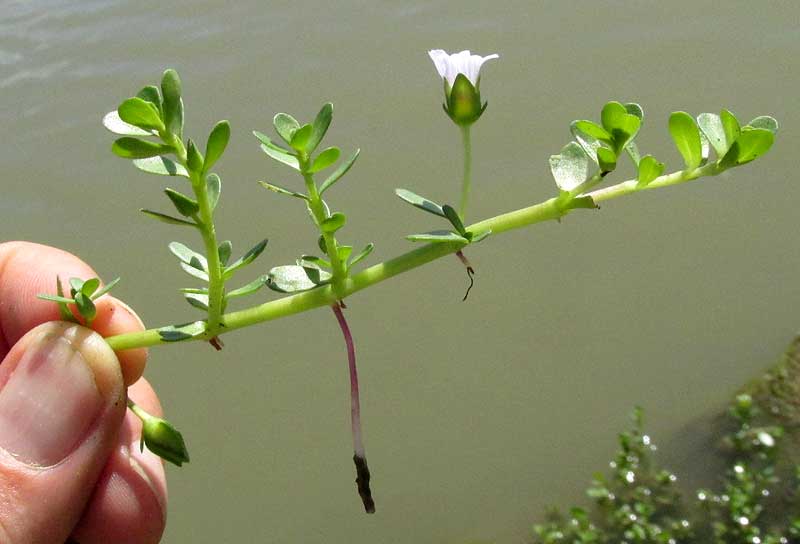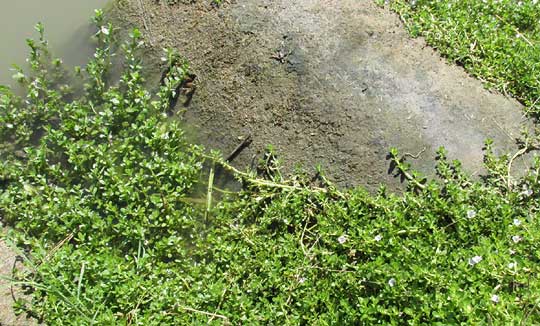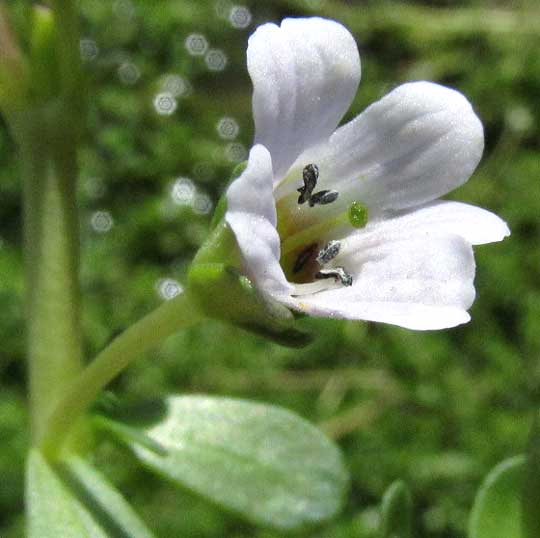Excerpts from Jim Conrad's
Naturalist Newsletter

from the August 31, 2014 Newsletter issued from the Frio Canyon Nature Education Center in the valley of the Dry Frio River in northern Uvalde County, southwestern Texas, on the southern border of the Edwards Plateau; elevation ~1750m (~5750 ft); N29.62°, W99.86°; USA
WATER-HYSSOP
Cook's Slough Nature Park on Uvalde's south side is built around a series of interconnected artificial holding ponds filled with treated sewage water from Uvalde. The ponds purify the water enough to be released into the environment, and the ponds themselves attract plants and animals otherwise not to be seen in the dry scrub surrounding the park. On a low levee between ponds, around a concrete culvert conducting water between ponds, a much branching, sprawling herb formed a lush, green, carpet at the water's edge, as shown below:

At the picture's lower, right corner, sprigs of the plant on dry land bear tiny, white blossoms, while at the picture's left flowerless stems emerge from below the water, rising into the air. A flowering sprig from shallow water at the water's edge is shown at the top of this page.
Here you see that the plant's leaves are opposite (two leaves per stem node), that thick roots develop at stem nodes, and that the flower also arises at a stem node. Many plant species never root at their nodes, and many produce their flower clusters at stem tips. Also, notice that the flower's green, cup-like calyx with five sepals is subtended by two green, scale-like bracts, or "bracteoles." A peep into the flower's mouth is afforded below:

In this picture two features helping in this plant's identification are that the stamens are "didynamous," and the stigma is "capitate." Didynamous stamens are those occurring four per flower, in two pairs of different lengths. The word "capitate" means "formed like a head," as opposed to being sharp-pointed, flat, or some other shape, so that fits our capitate stigma, which is the green, rounded-topped item atop the style issuing from the flower's center.
If we had fruits, we'd see that they are dry capsules that split open to release many small seeds, and such fruits associated with such plants bearing such flowers suggest the Figwort or Snapdragon Family, the Scrophulariaceae.
With our little mat-forming herb having opposite, unlobed leaves, five sepals not four, and corolla lobes or petals much longer than the cylindrical part of the corolla below them, the plant keys out to the genus Bacopa, species of which often are referred to as water-hyssops. Two water-hyssop species are listed for area.
In southwestern Texas, to know which water-hyssop species we have, it's enough to see that the leaves have only one vein down their middles, not several radiating from the blade bases. This is what's often called Coastal Water-hyssop, and sometimes Herb-of-grace -- BACOPA MONNIERI. Coastal Water-hyssop occurs worldwide in tropical and otherwise warm places. In the US it thrives in watery habitats throughout the southern coastal states. Over its huge area of distribution its corolla color can range from white to purple and blue.
If you look up Bacopa monnieri on the Internet you'll find plenty of pages about it, but most won't call the plant Coastal Water-hyssop. The main name used in cyberspace is "Brahmi," and those pages extol the plant's fame in the service of Ayurvedic medicine, where it is noted as "... an effective and powerful herb helpful for memory and combating stress." One website sells a plastic bottle of 180 capsules containing Brahmi for $37.20.
Bacopa monnieri's Wikipedia page has sections on its biology, traditional uses, pharmacology and toxicology at https://en.wikipedia.org/wiki/Bacopa_monnieri.